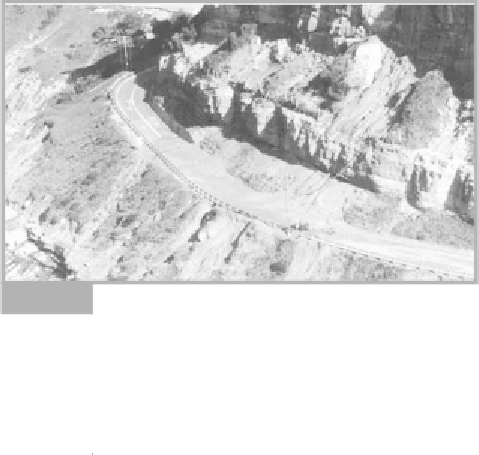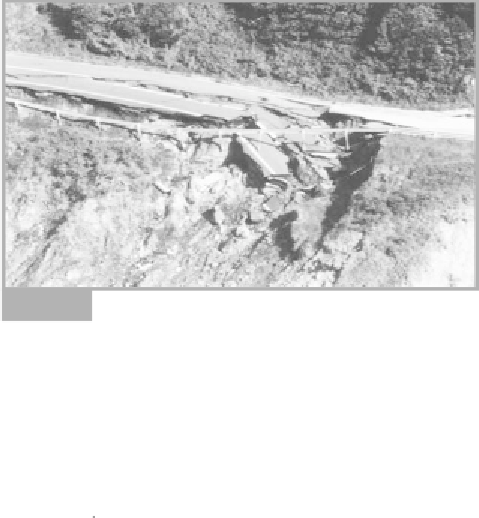Geoscience Reference
In-Depth Information
The cool water that develops off the South American
coastline can drift northward, and flood a 1-2° band
around the equator in the central Pacific with water
that may be as cold as 20°C. This phenomenon is
termed
La Niña
(meaning, in Spanish, 'the girl') and
peaks between ENSO events. The 1988-1990 La Niña
event appears to have been one of the strongest in
40 years and, because of enhanced easterly trades,
brought record flooding in 1988 to the Sudan,
Bangladesh and Thailand in the northern hemisphere
summer. In the Sudan, the annual rainfall fell in fifteen
hours, destroying 70 per cent of that country's houses.
Regional flooding also occurred in Nigeria, Mozam-
bique, South Africa, Indonesia, China, Central
America, and Brazil. An unusual characteristic of this
event was the late onset of flooding and heavy rain.
Both the Bangladesh and the Thailand flooding
occurred at the end of the monsoon season. Bangladesh
was also struck by a very intense tropical cyclone in
December 1988, outside the normal cyclone season.
In eastern Australia this same La Niña event
produced the greatest rainfall in 25 years, with contin-
uation of extreme rainfall events. Over 250 mm of
rainfall on 30 April 1988 caused significant damage
along a stretch of the coastal road between Wollongong
and Sydney. Numerous landslides and washouts under-
mined the roadway and adjacent main railway line,
leading to a total road repair cost, along a 2 kilometer
stretch of coastline, of $A1.5 million (Figure 2.9).
Slippage problems were still in evidence there
15 months later. The Australian summers of
1989-1990 not only witnessed record deluges but also
flooding of eastern rivers on an unprecedented scale.
Lake Eyre filled in both years, whereas it had filled
only twice in the previous century. Towns such as
Gympie, Charleville (Queensland), and Nyngan (New
South Wales) were virtually erased from the map.
The La Niña event of 1987-1988 was one of the
strongest at the end of the twentieth century.
Extreme rainfall fell throughout eastern Australia.
A)
Fig. 2.9A
Fans deposited on the coastal road between
Wollongong and Sydney following more than
250 mm of rainfall on 30 April 1988.
B)
The same rainfall event in A) caused numerous land-
slides and washouts that undermined the roadway and
adjacent main railway. The total cost in road repairs
along this 2 km stretch of coastline was $A1.5 million.
Slippage problems as a result have continued for
15 years (photographs by Bob Webb, courtesy of Mal
Bilaniwskyj and Charles Owen, New South Wales Depart-
ment of Main Roads, Wollongong and Bellambi Offices).
Fig. 2.9B
Global long-term links to drought and floods
(Quinn et al., 1978; Pant & Parthasarathy, 1981; Bhalme
et al., 1983; Pittock, 1984; Adamson et al., 1987)
India and China, respectively. In China people ate the
edible parts of houses, while in the Sudan there were
so many corpses that vultures and hyenas became fussy
about the ones they would eat.
Severe droughts can occur simultaneously around
the globe. In the twentieth century, the 1997-1998
ENSO event brought severe drought to South America
from Colombia to north-eastern Brazil, the Caribbean,
Central America, Hawaii, northern China and
Korea, Vietnam, Indonesia, Papua New Guinea, and
Bangladesh (East Pakistan). Southern Peru, western
Where the Southern Oscillation is effective in control-
ling climate, it is responsible for about 30 per cent of
the variance in rainfall records and some of the largest
death tolls in the resulting famines. Over 10 million
people died in the state of Bengal during the
1769-1770 ENSO event, while the event of 1877-1878
- one of the strongest ENSO events recorded - was
responsible for the deaths of 6 and 13 million people in











